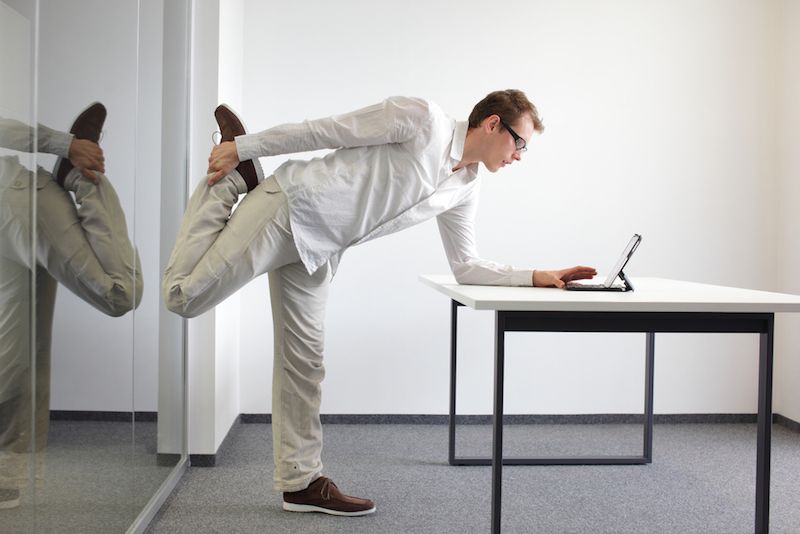Do Sit-Stand Desks Improve Workers' Fitness?

Desks that let you sit down or stand up to work may be a trendy piece of office furniture, but the health benefits of these desks are largely unproven, a new Cochrane Review study suggests.
The researchers found that there's not yet much high-quality evidence to support the widespread use of these popular desks, which let you adjust the height of the work surface so that you can either sit or stand. From the six studies done on sit-stand desks included in the review, the researchers concluded that workers who used them logged from 30 minutes to 2 hours less sitting time per day than their colleagues who used conventional desks.
The review concluded that currently, there is very low-quality evidence that sit-stand desks can reduce sitting at work in the short term, and no evidence of their long-term effectiveness, according to the study, published today (March 16) in the journal The Cochrane Library.
It was not surprising that sit-stand desks may have limited proven benefits, because they are attempting to solve a difficult problem, said Dr. Jos Verbeek, an author of the review and an occupational health physician at the Finnish Institute of Occupational Health in Kuopio, Finland. The idea behind the desk is that a worker spends more time standing, expending more energy during the day and generally moving around more while at work, he explained. [Don't Sit Tight: 6 Ways to Make a Deadly Activity Healthier]
However, many jobs these days involve working at a computer, which means people sit still all day, Verbeek said. "Working at a computer and moving more at the same time seem difficult to combine," he said.
Verbeek said he was surprised to see that there were only small studies of the sit-stand desks, and that they were set up by enthusiasts of the concept. There are no big studies of them, he told Live Science.
But before cubicle dwellers smugly park their backsides on their chairs at a more traditional desk for their daily marathon of sitting, they may want to note that there's plenty of evidence that sitting for long periods of time at work is a health concern that can increase a person's risk for obesity, heart disease, diabetes and a shorter lifespan.
Sign up for the Live Science daily newsletter now
Get the world’s most fascinating discoveries delivered straight to your inbox.
Sitting less at work
For the new review, the researchers looked at data from 20 published studies involving about 2,200 employees ages 18 and older whose jobs involved sitting at a desk.
The studies evaluated not only sit-stand desks, but also other workplace strategies aimed at reducing sitting time at work — from active workstations, like a treadmill desk or a bicycle under the desk, and changes in workplace layouts, such as placing printers further away from desks — to encouraging workers to walk during breaks and giving them computer reminders to stand up or be more active. The researchers looked at people who worked at places where these strategies were used and compared them to individuals whose workplaces did not implement these same strategies.
But the findings showed that these strategies didn't make much of a dent in workplace sitting time in the short term, and there was little to no information on their long-term impact. What's more, many of the existing studies had a small number of participants or were poorly designed, the researchers said.
There is definitely a need to find out how to best reduce sitting at work and increase activity, Verbeek told Live Science. It might be that standing at a desk is one strategy, but it could also be that work needs to be organized in a different, innovative way, he said.
One group of international experts has recommended that desk-based workers try to accumulate 2 to 4 hours of standing or light activity a day, at work or outside of it.
Although more active than sitting, "standing is still inactive, and probably won't counterbalance the effects of sitting very much," Verbeek noted. Larger studies with at least hundreds of participants and follow-up periods of one to several years are needed to find out what happens to people's health when they sit less, he said.
For now, researchers don't yet know which strategies may be effective at cutting back on sitting time at work. Standing could be beneficial, but it can also be that putting the printer at the far end of the hall is helpful, Verbeek suggested.
Or it might be that workers need to change the way they have meetings or telephone conversations in ways that might make them more active, he said. Having a pedaling device under the desk may be a simple and worthwhile approach, but scientists still don't know what the best methods are, Verbeek admitted. [9 Healthy Habits You Can Do in 1 Minute (Or Less)]
Until more is known, the best advice for people whose jobs involve plenty of sitting is to "try to be active and get regular exercise, both at work and outside of it," Verbeek said.
Follow Live Science @livescience, Facebook & Google+. Originally published on Live Science.
Cari Nierenberg has been writing about health and wellness topics for online news outlets and print publications for more than two decades. Her work has been published by Live Science, The Washington Post, WebMD, Scientific American, among others. She has a Bachelor of Science degree in nutrition from Cornell University and a Master of Science degree in Nutrition and Communication from Boston University.












